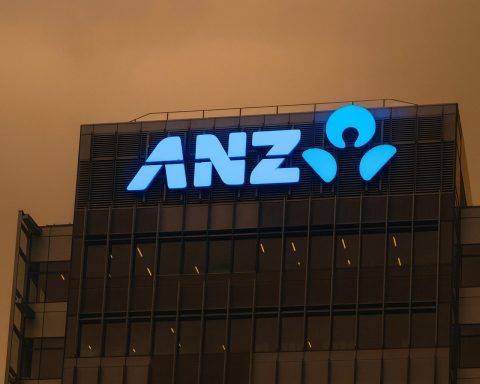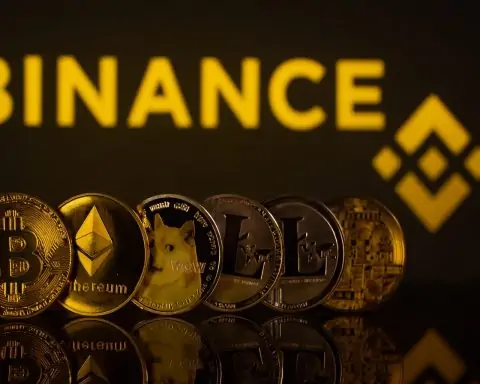- Whale-driven plunge and rebound: Dogecoin’s price suddenly dropped about 8% to around $0.25 after large holders (“whales”) sold heavily at roughly $0.27 resistance, but late buying by those same whales helped stabilize the coin near the $0.25 support level [1]. This rapid whale-driven sell-off and recovery underscores $0.25 as a critical floor for DOGE in early October.
- Big holders accumulating: On-chain data confirm that whales aggressively accumulated roughly 30 million DOGE (over $7 million worth) during the recent dip, contributing to the rebound above $0.25 [2]. In fact, the top 1% of richest Dogecoin addresses now control about 96% of the coin’s total supply [3] – a striking concentration that can amplify both rallies and sell-offs.
- Bullish technical signals: Dogecoin has broken out of a months-long downtrend channel and formed an ascending triangle pattern, indicating tightening consolidation with a bullish bias [4]. Buyers repeatedly defended the $0.251–$0.252 zone, while the ceiling around $0.265–$0.27 is being tested [5]. Chart analysts note a potential “golden cross” (when the 50-day moving average crosses above the 200-day) looming, and traders are eyeing a breakout toward $0.30 if DOGE can close above the $0.27 resistance [6]. Some optimistic forecasts even envision a further 20%+ upside (into the mid-$0.30s) should momentum hold, though this would likely require a surge in trading volume and market-wide strength.
- Institutional interest and ETFs: Dogecoin is steadily gaining legitimacy among institutional investors. A DOGE-focused fund (ticker DOJE) launched in September and gathered $20+ million in its first weeks [7], marking one of the first times institutional capital flowed into Dogecoin. Additionally, the U.S. SEC is reviewing 16 crypto ETF proposals this month – including a proposed Dogecoin ETF – although the U.S. government shutdown in early October threatened to delay these decisions [8]. Notably, regulators have already clarified that Dogecoin is not deemed a security in the U.S., removing a major legal overhang [9].
- Ecosystem developments: Beyond price moves, developers are working to improve Dogecoin’s technology and use-cases. The Dogecoin Foundation’s “DogeOS” team has proposed a zero-knowledge proof upgrade (via a new
OP_CHECKZKPopcode) to enable DeFi, smart contracts, and even gaming applications on Dogecoin without altering its core proof-of-work design [10]. “This would let Dogecoin maintain its simple PoW design while becoming a settlement layer for DeFi, gaming, identity and privacy applications,” explained DogeOS director Timothy Stebbing in a recent update [11]. Efforts like “CleanCore” are also underway to bring more professional treasury management to the Dogecoin ecosystem (as over 200 companies now use crypto in their treasuries) in hopes of dampening volatility [12].
Roller-Coaster Week for DOGE Prices
Early October 2025 has been a roller-coaster ride for Dogecoin. After steadily rising into the first week of “Uptober” – even briefly peaking around $0.2701 – the meme-inspired cryptocurrency was met with intense selling pressure at that level [13]. On October 7, large holders (“whales”) apparently took profits en masse near the $0.27 resistance, triggering a sharp intraday drop of about 8% [14]. During the steepest two-hour downturn, over a billion DOGE changed hands as stop-losses cascaded and short-term traders bailed out [15]. This whale-driven wave of liquidations pushed Dogecoin down to the mid-$0.24s at its lowest point, making it one of the coin’s widest trading sessions in recent weeks in terms of price range [16].
Crucially, however, that plunge was short-lived. By late trading on the 7th, buyer demand – including “smart money” likely from some of those same whales – came rushing back in around the key $0.25 level, halting the decline [17]. CoinDesk reported that support at $0.25 proved “resilient,” as that price zone triggered whale accumulation and short-covering, preventing a deeper slide into the $0.24s [18]. In the final hour of trading, DOGE even managed a modest bounce off the lows, climbing roughly 1% from the bottom and pushing back above $0.25 on steady large-volume purchases (blocks of 30 million DOGE at a time) [19]. This late rebound formed a tentative double-bottom pattern on intraday charts, hinting that $0.247–$0.250 may serve as a strong support base for now. By the morning of October 8, Dogecoin was consolidating in the ~$0.25 area – bruised but largely holding its weekly gains after the volatile swing. Traders are now watching to see if this proven support zone can hold in the coming days [20] [21].
Whale Accumulation at Key Support
Blockchain data backs up the notion that big players were bargain-hunting during Dogecoin’s dip. On-chain analytics indicate significant accumulation by large holders as prices neared the $0.25 floor. In early October alone, whale wallets (the biggest holders) added approximately 30 million DOGE to their balances – over $7 million worth at prevailing prices [22]. This burst of buying by whales not only helped buoy the market in the short term, but also reflects a broader accumulation trend: mid-tier wallets (smaller whales) similarly boosted their holdings by tens of millions of DOGE through the first week of October [23]. Such accumulation reduced the sell-side float (coins available on exchanges), as evidenced by about $25 million in net DOGE outflows from exchanges over 24 hours – suggesting holders moved assets into cold storage for longer-term holding [24].
The dominance of whale investors in Dogecoin’s ecosystem is striking. According to CoinDesk data, the top 1% of Dogecoin addresses now control over 96% of the total supply [25]. This extreme concentration means that a few big players can heavily influence price action – both positively (by soaking up supply during dips) and negatively (by selling into rallies). Analysts note that such a supply distribution “boosts upside volatility but poses risk of large sell-offs” if those whales decide to dump holdings later [26]. For now, though, whale behavior appears to be supportive, as they’ve defended $0.25 and even pushed DOGE above $0.27 during the recent rally by accumulating aggressively [27]. Tracking whale wallet activity will remain crucial going forward – any sign of distribution (whales sending coins to exchanges) could foreshadow another correction, whereas continued accumulation would underpin the bullish case for Dogecoin.
Technical Patterns Point to a Breakout
Despite the mid-week turbulence, Dogecoin’s technical setup is looking increasingly optimistic by classic chart analysis. Since late September, DOGE’s price has been coiling into an ascending triangle formation – a pattern marked by rising lows (higher troughs) and a relatively flat resistance ceiling. In this case, the base of the triangle has been around the $0.247–$0.250 support zone, with the horizontal resistance around $0.265–$0.27 [28]. Buyers have repeatedly defended the $0.25 area, each time lifting the price a bit higher after dips, while rallies have so far been capped just below $0.27. Such ascending triangles often precede bullish breakouts if the upper resistance is decisively breached. Indeed, Coindesk analysts note that a strong move above $0.27 would “trigger targets in the $0.27–$0.30 zone,” as per measured move projections [29]. In other words, clearing $0.27 could open the door to Dogecoin testing the next psychological level at $0.30 in short order – a target echoed by many traders on social media.
Momentum indicators are adding to this constructive picture. Market observers have pointed out that Dogecoin’s 50-day moving average is close to crossing above the 200-day MA – an event known as a “Golden Cross,” typically seen as a bullish signal of upward trend reversal [30]. If this crossover confirms, it would be the first golden cross for DOGE in many months, potentially attracting technical-focused buyers. Additionally, Dogecoin’s recent push from ~$0.23 in September up to the current mid-$0.25s has put it above several key Fibonacci retracement levels from its previous decline. According to TradingView data, DOGE is consolidating gains near the 23.6% Fibonacci retracement of the last upswing (from roughly $0.2507 to $0.2701) [31], indicating a healthy pause after its initial jump. Holding above the 23.6% or 38.2% Fib levels is often interpreted as a sign of strength (shallow pullback) in an uptrend. Meanwhile, the Directional Movement Index (DMI) and other trend metrics have flipped positive in recent days, confirming an uptick in bullish momentum [32]. All these technical clues suggest Dogecoin may be gearing up for another leg higher – provided that broader market conditions remain favorable and that the $0.24–$0.25 support band isn’t violated in the interim.
Of course, overhead resistance must be respected. The supply zone around $0.27 – which coincides with Dogecoin’s late August highs – remains the near-term hurdle. A few attempts to conquer $0.27 have failed on high volume, showing that some holders are still eager to take profits there [33]. Analysts caution that sustained closes above $0.27 will be needed to “flip the trend bias higher” and officially exit the current consolidation range [34]. If Dogecoin can achieve that, technical charts indicate a potential measured move toward the $0.30–$0.33 area initially, and possibly even as high as ~$0.40 in an extended breakout [35] [36]. On the downside, if $0.25 fails as support on a daily closing basis, traders expect the next support around $0.24 or $0.22 to be tested [37] – which would weaken the bullish setup and might delay any rally toward $0.30. In summary, Dogecoin’s chart favors the bulls right now, but the coin is waiting for a catalyst (or a tide of buy volume) to clearly punch through that $0.27 resistance ceiling.
“Uptober” Rally and Meme-Coin Momentum
Dogecoin’s recent moves haven’t happened in isolation – they coincide with a broader crypto market surge that has made October 2025 live up to its “Uptober” nickname. Most notably, Bitcoin ripped to a new all-time high above $125,000 on October 5th [38], and at last check was holding near $121K–$122K [39]. Major crypto rallies often create a rising tide that lifts altcoins, and Dogecoin has indeed ridden on Bitcoin’s bullish coattails this month. As Bitcoin and Ethereum climbed (with Ether hitting ~$4,500 [40]), liquidity and risk appetite flowed into more speculative assets like meme coins. Dogecoin’s price jumped ~5% on October 5 alone (to about $0.26) amid this euphoric market mood [41], and it extended those gains on October 6 when the whale-buying news further boosted confidence. Its main rival Shiba Inu (SHIB) also saw a bump – roughly +5% over the week – but DOGE’s ~10% weekly rise and ~$25 billion market cap firmly re-established it as the top “meme coin” of this rally phase [42].
Social media sentiment around Dogecoin has likewise spiked during the rally. Mentions of DOGE on X (formerly Twitter) were up 40% month-over-month through early October [43], reflecting a resurgence of retail enthusiasm. Popular crypto influencers and traders have been chattering about Dogecoin’s next moves. For instance, pseudonymous analysts like “Cas Abbé” and “Trader Tardigrade” have publicly predicted that if DOGE can clear the $0.30 barrier, it could quickly run another 20% higher into the mid-$0.30s [44]. Some even speculate about a long-term scenario where Dogecoin makes a run toward $1 by 2026, though that would likely require a sequence of major bullish events and widespread adoption to materialize [45]. This kind of FOMO (fear of missing out) talk is common whenever Dogecoin gains momentum, given its history of explosive moves.
That said, not all commentary is wildly optimistic – there are measured voices as well. Several analysts have noted that Dogecoin’s huge market capitalization (currently in the mid-20s of billions of dollars) means that each additional rally becomes harder to sustain in percentage terms [46]. In other words, doubling from here would require an enormous inflow of capital. There are also reminders that memecoins remain high-risk, often moving on hype rather than fundamentals. For example, regulators in some regions (like Singapore) have warned investors about speculative trading in tokens like DOGE and even hinted at stricter oversight or potential delistings if excessive mania builds up [47]. So while Dogecoin’s vibe has improved markedly this month – thanks to whales, bullish charts, and a frothy crypto backdrop – seasoned traders urge caution and proper risk management. The meme-coin mania can turn quickly, as history has shown, so participants are advised not to get overleveraged even as sentiment runs hot.
Institutional Interest and Regulatory Tailwinds
One of the most noteworthy developments for Dogecoin in 2025 has been the growing institutional interest in this once-dismissed meme asset. Perhaps the biggest milestone so far: the launch of a dedicated Dogecoin investment fund. In September, asset managers Rex Shares and Osprey teamed up to introduce what’s essentially a Dogecoin exchange-traded product (reportedly under ticker “DOJE”), and it attracted over $20 million in assets within its first week [48]. This was a significant moment because it “brings institutional capital into Dogecoin for the first time,” according to crypto news site CoinCentral [49]. The product gives traditional investors exposure to DOGE’s price without having to directly buy and custody the crypto, indicating a rising demand for regulated avenues to invest in Dogecoin. It effectively legitimizes DOGE beyond pure retail speculation, though it remains to be seen how much impact such funds can have on price given Dogecoin’s large market size [50]. Still, the early uptake signals that some institutional players see Dogecoin as an asset worth betting on – a remarkable shift for a coin that began as a joke.
In the same vein, multiple Dogecoin-linked ETF proposals are in the pipeline. The U.S. Securities and Exchange Commission (SEC) has a slate of 16 crypto ETF applications to rule on in October, one of which includes a Dogecoin-focused ETF [51]. These proposed exchange-traded funds – if approved – would further ease access to DOGE for investors via stock markets. However, there has been some uncertainty due to U.S. political gridlock: the recent federal government shutdown threatened to delay the SEC’s decision-making timeline in early October [52]. Even so, analysts remain optimistic that a Dogecoin ETF (likely a futures-based or basket ETF) could eventually get the green light. Industry watchers have assigned a 68–90% probability that U.S. regulators will approve some form of spot Dogecoin ETF by later in 2025, especially after the SEC introduced new generic listing standards that make such approvals more straightforward [53]. This confidence is bolstered by the fact that the SEC in February 2025 explicitly stated Dogecoin is not a security [54] – removing a huge regulatory hurdle that hung over many altcoins in previous years. With that clarification, Dogecoin doesn’t face the same legal risk of being deemed an unregistered security, so the path for institutional products is much clearer.
Outside the U.S., Dogecoin also benefits from regulatory developments. In Europe, the new MiCA (Markets in Crypto-Assets) framework has come into effect, allowing exchanges to list cryptocurrencies like Dogecoin under defined guidelines and oversight. This means European investors can trade DOGE on regulated venues with more confidence, potentially boosting liquidity. On the flip side, some regulators are urging caution: for example, Singapore’s financial watchdog has highlighted the risks of meme-coin speculation, suggesting that retail investors should be careful and that exchanges might even need to delist highly risky tokens if mania gets out of control [55]. So the regulatory environment is a bit of a mixed bag – largely positive in terms of clarifying Dogecoin’s legal status (good for long-term adoption), but also vigilant about the coin’s notorious volatility and the fervor of its fan base.
Net-net, the institutional and regulatory trend is more friend than foe to Dogecoin right now. The entrance of funds and ETFs, along with endorsement by way of non-security classification, provides a tailwind that simply didn’t exist in Dogecoin’s 2021 heyday. Each new institutional product or approval could incrementally broaden DOGE’s investor base. Still, market experts warn that Dogecoin’s core value remains community-driven and speculative – institutions may participate, but the coin’s price will likely continue to swing mainly on retail sentiment, social media buzz, and whims of major holders, rather than on traditional valuation metrics.
Development Updates and Use-Case Expansion
Amid the market excitement, the Dogecoin developer community and related projects have been quietly pushing forward on improvements that could expand DOGE’s utility. A headline effort on this front is the proposed integration of zero-knowledge proof (ZKP) technology into Dogecoin’s blockchain. In July 2025, the Dogecoin Foundation’s DogeOS team put forward a proposal for a new operation code called OP_CHECKZKP that would enable advanced cryptographic proofs on Dogecoin’s network [56]. If implemented, this upgrade could pave the way for zk-Rollups and other Layer-2 solutions on Dogecoin, potentially allowing for things like DeFi (decentralized finance) applications, smart contracts, and even blockchain gaming to run atop the Dogecoin chain [57]. Crucially, this would not change Dogecoin’s proof-of-work consensus or token economics; instead, it adds a new capability for verifying external proofs. “This would let Dogecoin maintain its simple PoW design while becoming a settlement layer for DeFi, gaming, identity and privacy applications,” explained Timothy Stebbing, director of the DogeOS project [58]. In essence, Dogecoin could gain features similar to Ethereum’s rollups – boosting throughput and functionality – without sacrificing the simplicity and security of the base chain. This plan is still in proposal stage, but it has generated buzz in the community and contributed to speculation that Dogecoin could eventually transcend its meme-coin roots to support more serious use-cases. Some analysts even mused that if such upgrades succeed, DOGE might revisit its all-time high (~$0.73 in 2021) and perhaps approach $1 in the long term, though that remains a highly aspirational scenario [59].
Another development angle is improving Dogecoin’s financial infrastructure and stability. One example is the initiative called “CleanCore,” which aims to introduce professional treasury management practices to entities handling Dogecoin [60]. The concept is that by treating DOGE reserves more like corporate treasuries – with hedging strategies, governance, and transparency – volatility could be reduced and confidence increased for businesses that want to use Dogecoin. This ties into a broader trend: over 200 companies have reportedly adopted some form of crypto treasury strategy in 2025 [61], hinting that some firms may be interested in holding or transacting in Dogecoin if it can be managed in a stable way. Additionally, Dogecoin’s community has been exploring DeFi integrations via bridges (like wDOGE on Ethereum or Dogechain solutions) to let DOGE holders participate in yield farming and lending on other chains. While Dogecoin doesn’t natively support smart contracts, these third-party workarounds and the potential future ZKP upgrade could make the coin more than just a hodl-or-tip asset.
Even merchant adoption shows glimmers of growth. Dogecoin remains a popular payment option for certain online stores, charities, and sports teams (the NBA’s Dallas Mavericks and several tech merchants accept it). The meme coin’s branding and community have proven to be an asset here – the lighthearted Shiba Inu dog logo is widely recognized, sometimes encouraging businesses to accept DOGE as a promotional novelty. As more mainstream brands dabble in crypto payments (e.g., via BitPay), Dogecoin often rides along thanks to its popularity. Each small adoption adds to the narrative that DOGE could evolve into a fun alternative payment network, especially for micro-transactions given its relatively low fees and fast block times. However, skeptics note that Dogecoin’s on-chain usage for payments is still modest compared to major networks, and real-world utility remains an area where DOGE has plenty of room to grow.
Market Outlook: Cautious Optimism Toward $0.30
Looking ahead, the consensus among crypto analysts is one of cautious optimism for Dogecoin – at least in the near term. The successful defense of the $0.25 level by whale buyers has many traders convinced that a rally toward $0.30 is achievable in the coming days or weeks [62] [63]. The combination of bullish technical patterns, renewed social media buzz, and positive macro momentum (with Bitcoin in a strong uptrend) provides a supportive backdrop for further gains. If DOGE breaks above its $0.27 resistance convincingly, it could trigger fresh FOMO buying and algorithmic trend-following that propel the price into the low-$0.30s relatively quickly [64]. Notably, the next key milestone of $0.30 is not just a round number but also roughly the high from April 2022 – surpassing it would mark Dogecoin’s highest price in over three years, likely drawing significant attention. Above $0.30, chart watchers see interim targets around $0.33, then $0.35–$0.37, with the more bullish scenarios pointing to the $0.40–$0.50 range if a true breakout occurs [65]. Such a strong move would probably require continued whale accumulation and perhaps a catalyzing event (for example, an ETF approval or a viral endorsement).
However, risks abound that could hinder Dogecoin’s ascent. For one, if the broader crypto market stalls or reverses, DOGE – being a high-beta asset – could magnify those losses. Any sign of hawkish turn in macroeconomic conditions (e.g. central banks not easing policy as expected) might sap the liquidity that’s been lifting speculative assets [66]. Dogecoin’s fate is also tied to its whimsical sentiment drivers; a lull in social media hype or a new meme-coin craze elsewhere could divert attention and funds away from DOGE. Furthermore, that heavy concentration of DOGE supply means the specter of a whale sell-off is never far. If a few top holders were to unload a chunk of their positions, it could easily knock the price back down before new buyers absorb the selling [67]. Traders will be monitoring whale addresses for any unusual outgoing transfers as an early warning sign.
On the flip side, upcoming news could surprise to the upside. Any progress on the ETF approval front – say the SEC approving a crypto ETF that includes Dogecoin, or the DOGE fund (DOJE) growing rapidly – would likely boost market confidence. Also, continued crypto-friendly signals from regulators (or at least no adverse rulings) will help sustain institutional interest [68]. Another wildcard is the influence of Elon Musk, the billionaire tech entrepreneur who famously pumped Dogecoin in the past. Musk has been quieter about Dogecoin recently, but news like his companies potentially integrating DOGE (e.g. Tesla merch or X/Twitter using Dogecoin) could instantly ignite a rally. Interestingly, Musk himself just achieved a historic personal wealth milestone (reportedly reaching a $500 billion net worth in early October) [69], which got Dogecoin fans speculating on social media if he might “celebrate” with some Doge-related announcement – though there’s no concrete evidence of that as of now.
In summary, Dogecoin enters mid-October 2025 with momentum on its side and realistic hopes of extending its rally, but also with the knowledge that volatility is the norm. The short-term focus is on $0.27 and $0.30: clearing those levels could confirm that the meme coin’s uptrend is back in business. Beyond that, achieving something like $0.40 or higher would likely require not just technical breakouts but fresh fundamental excitement – whether from adoption, technology upgrades, or big-name endorsements. Traders and investors are advised to stay alert and nimble. As the past week proved, Dogecoin’s fortunes can shift quickly; whales can become sellers just as fast as they became buyers. But for now, the tone is optimistic, and the beloved Shiba Inu-branded coin is once again a topic of lively conversation both on Wall Street and Crypto Twitter. DOGE’s next chapter – possibly a run at that elusive $0.30 – will be closely watched by friend and foe alike in the days ahead.
Sources: CoinDesk [70] [71]; TradingView [72]; TS2 (Tech Space 2.0) [73] [74]; CoinCentral [75] [76]; CoinDesk (Oct 6) [77] [78]; TS2 [79].
References
1. www.coindesk.com, 2. coincentral.com, 3. www.coindesk.com, 4. www.coindesk.com, 5. www.coindesk.com, 6. ts2.tech, 7. coincentral.com, 8. www.tradingview.com, 9. ts2.tech, 10. ts2.tech, 11. ts2.tech, 12. www.tradingview.com, 13. www.coindesk.com, 14. www.coindesk.com, 15. www.coindesk.com, 16. www.coindesk.com, 17. www.coindesk.com, 18. www.coindesk.com, 19. www.coindesk.com, 20. www.coindesk.com, 21. www.coindesk.com, 22. coincentral.com, 23. ts2.tech, 24. coincentral.com, 25. www.coindesk.com, 26. ts2.tech, 27. ts2.tech, 28. www.coindesk.com, 29. www.coindesk.com, 30. ts2.tech, 31. www.tradingview.com, 32. coincentral.com, 33. www.coindesk.com, 34. www.coindesk.com, 35. ts2.tech, 36. ts2.tech, 37. pintu.co.id, 38. ts2.tech, 39. www.coindesk.com, 40. ts2.tech, 41. ts2.tech, 42. ts2.tech, 43. ts2.tech, 44. ts2.tech, 45. ts2.tech, 46. coincentral.com, 47. ts2.tech, 48. coincentral.com, 49. coincentral.com, 50. coincentral.com, 51. www.tradingview.com, 52. www.tradingview.com, 53. ts2.tech, 54. ts2.tech, 55. ts2.tech, 56. ts2.tech, 57. ts2.tech, 58. ts2.tech, 59. ts2.tech, 60. www.tradingview.com, 61. www.tradingview.com, 62. coincentral.com, 63. ts2.tech, 64. www.coindesk.com, 65. ts2.tech, 66. www.coindesk.com, 67. ts2.tech, 68. ts2.tech, 69. coincentral.com, 70. www.coindesk.com, 71. www.coindesk.com, 72. www.tradingview.com, 73. ts2.tech, 74. ts2.tech, 75. coincentral.com, 76. coincentral.com, 77. www.coindesk.com, 78. www.coindesk.com, 79. ts2.tech










